In today’s competitive digital space, knowing how to position your ads correctly makes all the difference in Google Ads.
An intelligent ad placement strategy on the Google Display NetworkA collection of websites, apps, and videos where Google Ads can appear can help you reach an elevated level of brand presence, improve targeting, and help you reach the right audience at the right time.
Understanding the nuts and bolts of ad placement strategies can really help in investing wisely, hence boosting your ROIReturn on Investment, a measure of the profitability of an investment significantly.
Throughout this article, we’ll dive deep into a mix of Google Ads Display ad placement strategies.
We will also explore how those placements can be optimized to maximum effect.
Whether you are new to Google Ads or looking to further optimize your ongoing campaigns, this guide will equip you with actionable insights and tips on making the most out of every ad dollar spent.
From how to understand the Google Display Network itself to exploring core placement strategies and the importance of targeting, all will be covered to build an effective and results-driven approach.
With a vast reach, the Google Display Network provides an excellent avenue for businesses to engage prospects through different ad formats: text, image, and responsive display ads.
What’s unique about the Google Display Network is that it lets businesses reach people at any stage of their buying cycle, whether they are just discovering your brand or ready to buy.
Unlike search ads that target active searchers, the beauty of display ads lies in reaching out to people while they browse online and drawing attention at a time when they may not be actively looking for your product or service.
- Understanding Google Ads Display Network
- Core Ad Placement Strategies in Display Advertising
- Targeting Techniques to Enhance Ad Placement
- Optimizing Ad Performance Through Placement Reports
- Best Practices for Effective Google Ads Display Placement
- Conclusion: How to Master Ad Placement Strategies on Google Display Network
- Google Display Network Ad Placement Strategy FAQs
Understanding Google Ads Display Network
As the name suggests, the Google Display Network (GDN) enables advertisers to reach users beyond just Google search on other online platforms.
With the GDN encompassing partner websites, blogs, news pages, and even in-app on mobile, your ads could show almost anywhere within the network.
This is ideal for businesses wanting to create brand awareness and keep their products top-of-mind among potential customers.
Display ads are usually visual, making them more eye-catching and appealing than text ads.
They allow businesses to engage audiences with more creative expression.
The wide reach of the GDN further enables targeting of ads by geography, demographics, and interests to ensure that your messages reach the audience most likely to be interested in your offerings.

Visual representation of the advantages of display ads, showcasing increased engagement and brand visibility.
Benefits of Display Ads for Businesses
Using display ads on the Google Display Network brings several advantages to businesses.
Here are some key benefits:
- Increased brand visibility: With the GDN, displaying ads on a vast network of sites and apps boosts your brand’s visibility and awareness.
- Targeted advertising: GDN provides options for advanced targeting that include demographics, interests, and remarketing, ensuring your message reaches the most relevant audience.
- Cost-effective reach: The cost of display ads is generally lower than other forms of advertising, helping maximize the budget while reaching a broad audience.
- Engaging ad formats: Visual display ads drive user attention and engagement more effectively than simple text ads.
These advantages make Google Display Network ads a valuable addition to any digital marketing strategy, especially for enterprises looking to improve awareness and stay top-of-mind with potential customers.
As you delve deeper into the different ad placement strategies available, you’ll be better equipped to maximize the full potential of the Google Display Network.
The Google Display Network (GDN) provides access to millions of websites, apps, and videos, broadening your reach beyond search ads. It’s a powerful tool for building brand awareness and capturing audience attention with visual and engaging ads.

Illustration of digital advertising strategies with various ad formats displayed on devices.
Core Ad Placement Strategies in Display Advertising
Choosing the right ad placement strategy is essential in maximizing the impact of your Google Display ads.
Various strategies suit different campaign goals, from building awareness to generating direct conversions.
In this section, we will look at the best ad placement strategies available in the Google Display Network and how to use them effectively to achieve your advertising goals.

Visual representation of the Managed Placement Strategy in display advertising.
Managed Placement Strategy
In the Managed Placement Strategy, an advertiser can pre-select specific websites, apps, or YouTube channels where they’d like their ads to appear.
This targeted approach works best if you have insights into where your audience spends time online or if you want greater control over the context in which your ads show up.
Managed placements also allow you to exclude sites that may not align with your brand’s image, ensuring your ads appear in high-quality environments.
- Aligned placements: You can choose placements that align with your brand’s values and audience interests.
- Enhanced relevance: Choosing precise placements can increase ad relevance, boosting engagement and conversions.
- Selective exclusions: You can exclude placements that perform poorly or could potentially harm your brand’s reputation.
Using managed placements can yield impressive results, especially if you understand your audience’s browsing habits and preferences.
It’s particularly effective for brands with niche audiences or those seeking premium placement sites.

Visual representation of automated placements in display advertising, highlighting technology and efficiency.
Automated Placements: How They Work
Automated Placements provide a more hands-off approach, allowing Google’s algorithms to find relevant placements based on your targeting settings.
Google uses machine learningA branch of AI that enables systems to learn and improve from experience without explicit programming to place your ads on sites and apps likely to perform well, optimizing for clicks or conversions based on your campaign goals.
Automated placements save time and can help find new audience segments by showing your ads in places you may not have expected but that still work well.
- Less manual work: Google’s automation removes the need to manually select individual placements.
- Machine learning optimization: Google’s algorithms automatically optimize for the best-performing placements.
- Broader reach: Automated placements can help discover valuable new audiences you may not have previously considered.
This strategy is a cost-effective way to optimize campaigns without constant manual adjustments.

Visual representation of Responsive Display Ads adapting seamlessly across various devices.
Responsive Display Ads Placement
Responsive Display Ads are versatile ad formats that automatically adjust their size, appearance, and format to fit various placements across the Google Display Network.
By using responsive display ads, you ensure that your ads are optimized for a wide variety of placements, making them ideal for campaigns that need extensive reach and flexibility.
- Adapts to different placements: Responsive display ads automatically resize to fit the placement, ensuring they look professional everywhere.
- Wider reach: These ads allow you to tap into more placements, maximizing visibility and exposure.
- Efficient ad creation: With fewer creative variations needed, responsive ads save time in design and setup.
Responsive Display Ads are highly effective for reaching diverse audiences with minimal manual configuration.
Google’s automation tailors ad formats based on the placement environment.
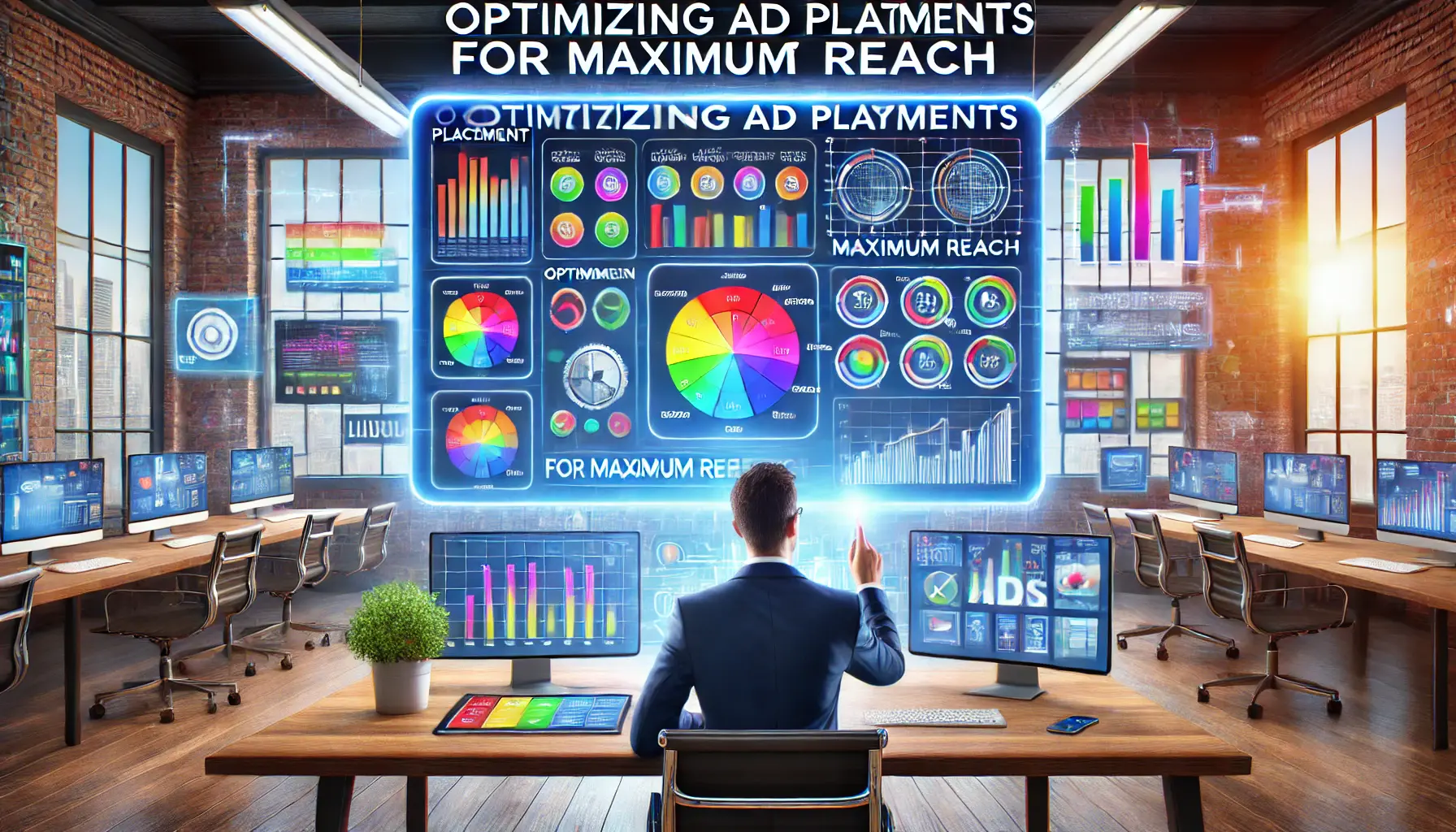
Visual representation of optimizing ad placements for enhanced reach in digital advertising.
Optimizing Placements for Maximum Reach
Optimizing your ad placements is a continuous process involving refining settings to ensure your ads appear in locations that yield the highest return.
To maximize reach, it’s essential to monitor placement performance and make data-driven adjustments.
Test different targeting methods, explore managed and automated placements, and exclude low-performing sites.
- Analyze performance data: Regularly reviewing metrics allows you to identify top-performing placements.
- Experiment with strategies: Testing various placement strategies helps reveal insights about what works best for your audience.
- Apply exclusions: Excluding placements that don’t deliver results helps optimize your ad spend.
By consistently refining placements, you can increase ad effectiveness, reduce costs, and enhance overall campaign performance, resulting in a more profitable investment in the Google Display Network over time.
Choosing the right placement strategy—whether managed, automated, or responsive—can dramatically enhance your campaign’s reach and relevance. Tailor your placements to align with your brand and target audience.

Visual representation of targeting techniques to enhance ad placement in digital marketing.
Targeting Techniques to Enhance Ad Placement
An effective ad placement strategy is not only about where the ad is shown but also about the precision of targeting.
Google Display Network provides a range of targeting techniques that enable advertisers to reach their desired audience, ensuring that ads appear in front of users most likely to engage.
In this section, we’ll explain key targeting methods in Google Ads Display that enhance ad serving and boost overall campaign performance.

Visual representation of interest and demographic targeting in digital marketing.
Interest and Demographic Targeting
Interest and demographic targeting allows advertisers to reach users based on their web interests, habits, and demographic data.
Google categorizes users according to browsing behavior, allowing advertisers to serve ads to people with an interest in related topics.
This method is highly effective for building brand awareness and engaging users who may not actively search for your product but fall within the interest scope of your offerings.
- Affinity audiences: Target users with long-term interests, such as hobbies or lifestyle preferences, helping to develop a broad but relevant audience.
- In-market audiences: Reach users actively researching or planning to buy similar products or services, boosting conversion rates.
- Demographic targeting: Customize ads to specific age groups, genders, or household income levels, making messaging more relevant to each target group.
Both early and later buying cycle users notice interest and demographic targeting, increasing reach within targeted segments.

Visual representation of contextual and keyword targeting in digital advertising.
Contextual and Keyword Targeting
Contextual and keyword targeting allows your ad to appear on websites containing keywords or themes relevant to your product.
Google’s algorithm analyzes webpage content to place ads on pages aligned with the keywords you choose, ensuring your ads appear in a context closely related to what you offer.
This approach is particularly potent for reaching users when they engage with content similar to your offerings.
- Topic targeting: Display ads on sites categorized under broad industry topics, increasing exposure within relevant subject areas.
- Keyword targeting: Select keywords that Google will match to webpage content, enhancing the contextual relevance of your ads.
- Custom Intent audiences: Create custom audiences based on specific keywords and URLs that reflect intent, allowing more precise targeting.
Contextual and keyword targeting ensure your ad appears in environments that reinforce its message, improving engagement rates and brand alignment.
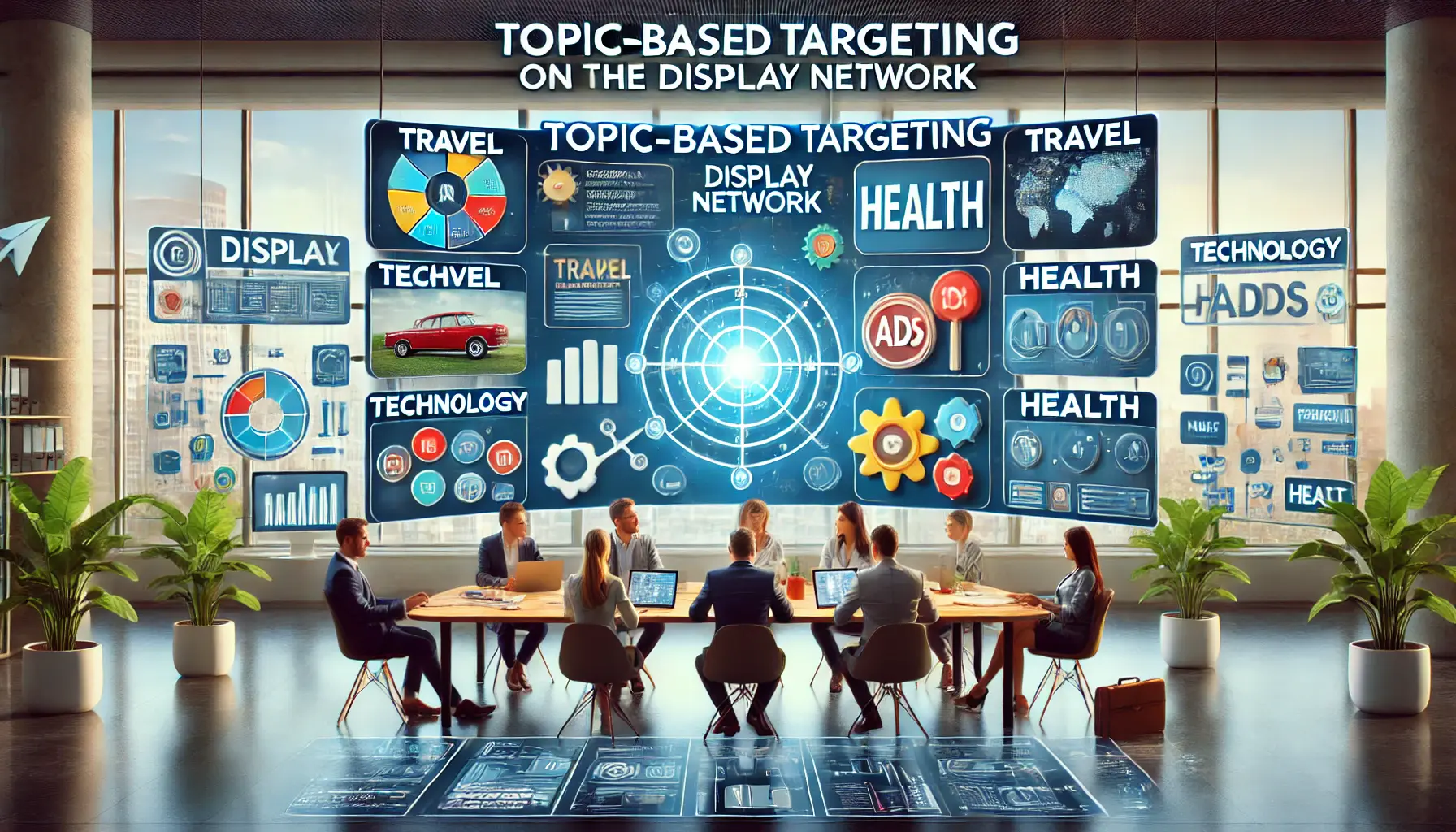
Visual representation of Topic-Based Targeting on the Display Network in digital advertising.
Topic-Based Targeting on Display Network
Topic-based targeting enables advertisers to place ads on websites, videos, and apps grouped under specific topics.
By selecting topics related to your industry, you can increase visibility among users who may be interested in your products.
This broad targeting option is ideal for brands looking to drive awareness across various sites within a related field.
- Enhanced brand visibility: Reach users exploring topics relevant to your business, even if they haven’t shown explicit intent.
- Scalable audience reach: Easily expand reach by targeting multiple topics within your industry.
- Combined targeting options: Complement topic targeting with other methods for more precise audience segmentation.
Using topic-based targeting broadens your brand’s exposure to potential customers who may not be in the buying phase yet, creating a presence across relevant digital spaces.

Visual representation of Custom Intent Audiences and Remarketing in digital advertising.
Custom Intent Audiences and Remarketing
Custom intent audiences and remarketingA strategy that targets users who have previously interacted with your website or app enable advertisers to target users who have shown interest in products similar to yours or have previously interacted with your brand.
This method is highly effective for reaching users at different stages of the customer journey, particularly those needing an extra push toward conversion.
- Custom intent audiences: Target users based on searches, online behavior, and visited websites, ensuring ads reach those interested in related products.
- Remarketing: Re-engage users who previously visited your site, encouraging them to return and make a purchase.
- Dynamic remarketing: Show personalized ads to past site visitors featuring products they viewed, creating a tailored ad experience.
Using custom intent audiencesAudiences created based on specific keywords and URLs to reflect users' intent and remarketing enhances ad performance, as these methods allow for highly personalized messaging tailored to user behavior and interests.
Employing these targeting techniques ensures that your ad placement strategies reach the most relevant users, increasing engagement and conversions across the Google Display Network.
Targeting on the Google Display Network goes beyond basic demographics. Employing interest, contextual, and keyword targeting improves ad relevance and reaches audiences most likely to engage with your content.

Visual representation of optimizing ad performance using placement reports in digital marketing.
Optimizing Ad Performance Through Placement Reports
Tracking and analyzing your ad placements is essential for understanding how well your ads perform on the Google Display Network.
Placement reports provided by Google Ads allow advertisers to review the performance of their ads across various sites, apps, and video channels.
This enables you to optimize ad placements for the best performance, ensuring that your budget is used effectively.

Visual representation of analyzing placement performance data in digital advertising.
Analyze Placement Performance Data
Placement performance data provides insights into where your ads appear, including specific sites and their performance.
This data helps identify high-performing placements that bring in quality traffic and conversions, as well as underperforming placements that may drain your budget.
- Identify top placements: Look for placements with high click-through and conversion rates, indicating strong user engagement and relevance.
- Spot poor-performing placements: Analyze placements with low engagement to determine if they should be blocked or refined.
- Optimize targeting based on data: Use insights from performance reports to fine-tune your targeting settings and increase ad relevance.
By regularly analyzing placement performance data, you can make informed decisions, ensuring that your ads appear in locations that deliver the best results.
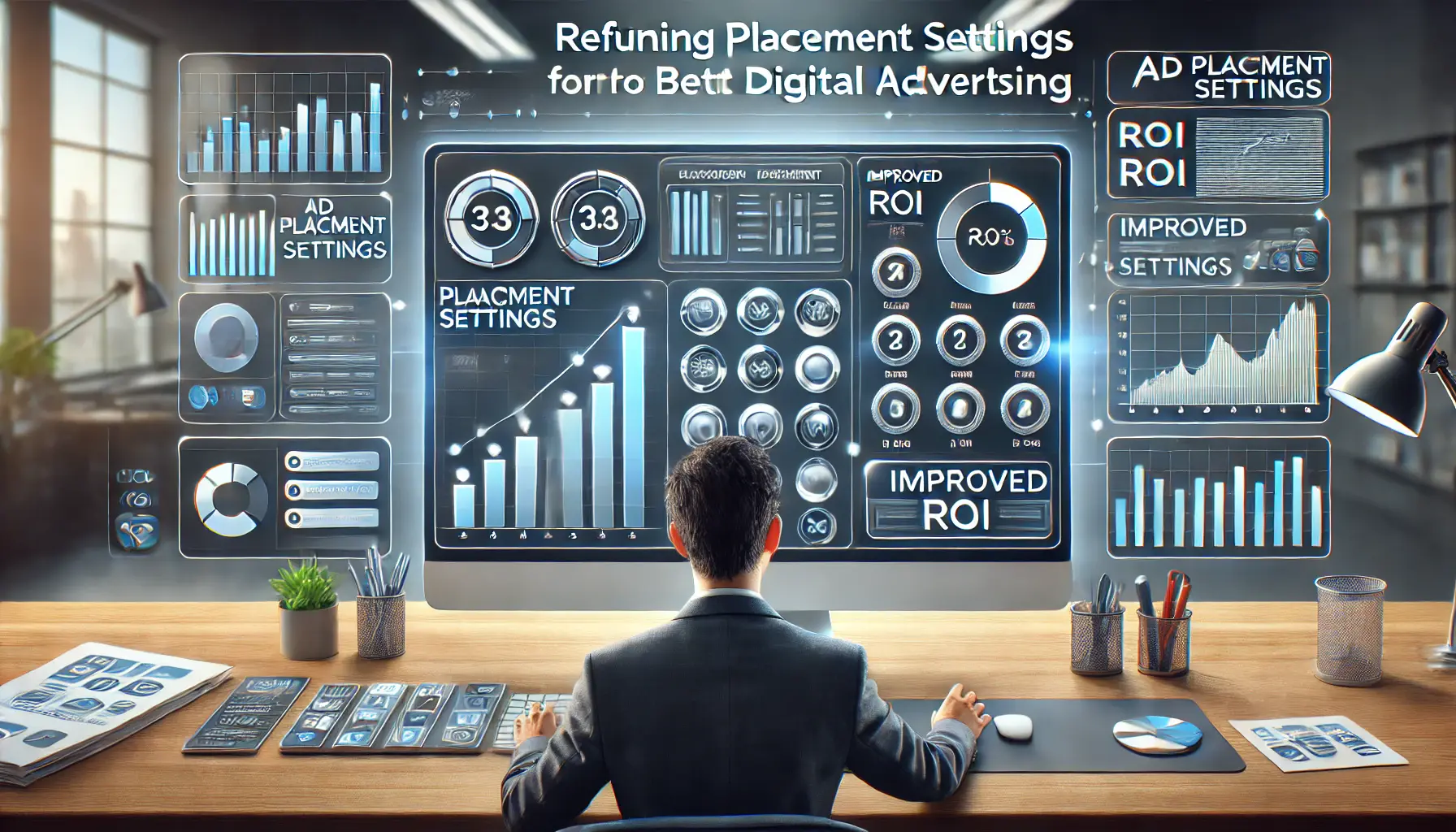
Visual representation of refining ad placement settings to achieve better ROI in digital advertising.
Refine Placement Settings for Better ROI
Refining your ad placement strategy is crucial for maximizing ROI.
Using data from placement reports, you can adjust settings to favor high-value placements and eliminate those that don’t contribute to your objectives.
- Set bid adjustments: Increase bids for high-value placements and decrease or exclude bids for low-value placements.
- Test different placement types: Experiment with placements across websites, apps, and YouTube to determine which formats perform best for you.
- Optimize ad formats: Use responsive display ads to improve performance on diverse placements, ensuring adaptability across sites.
Fine-tuning your settings based on placement data can significantly enhance ad performance, making it essential for any Google Ads Display campaign.

Visual representation of using exclusions to optimize ad placements in digital advertising.
Using Exclusions to Control Ad Placements
Placement exclusions allow you to prevent your ads from appearing on sites or apps that don’t align with your brand or deliver poor results, helping you allocate your budget more effectively.
- Exclude underperforming placements: Identify and exclude low-performing placements to improve overall campaign efficiency.
- Ensure brand safety: Use exclusions to prevent ads from appearing on sites with inappropriate content that could harm your brand’s image.
- Optimize spend distribution: Redirect budget to high-value placements, focusing on the best sites that meet your standards.
Taking a strategic approach to exclusions enables you to control where your ads appear, increasing effectiveness and maintaining brand safety.

Visual representation of leveraging Google Analytics to gain insights into ad placements.
Leverage Google Analytics for Placement Insights
Integrating Google Analytics with Google Ads provides deeper insights into user behavior on your placements, helping you refine your ad placement strategy further.
With Google Analytics, you can analyze granular metrics that reveal how users interact with your site after clicking your ads.
- Track conversion paths: Understand the paths users take from your ad to conversion points, helping identify high-value placements.
- Measure engagement metrics: Analyze metrics like bounce rate, session duration, and pages per session to assess placement quality.
- Set up goals and events: Use goals and events in Google Analytics to track specific user actions, helping identify placements that drive desired behaviors.
Leveraging Google Analytics for placement insights gives you a comprehensive view of ad performance, enabling you to optimize placements for engagement and conversions.
This data-driven approach ensures that your Google Display campaigns are impactful and profitable.
Regularly reviewing placement reports allows for data-driven adjustments. By analyzing which placements work best, you can make strategic decisions to improve campaign effectiveness and efficiency.

Visual representation of best practices for optimizing Google Ads display placements.
Best Practices for Effective Google Ads Display Placement
Applying effective ad placement strategies on the Google Display Network is crucial to ensuring that your ads are seen by the right users.
By following the best practices outlined below, you can increase ad visibility, improve user engagement, and ultimately drive better results.
In this section, we will highlight key practices that can make your Google Ads Display placements more effective.
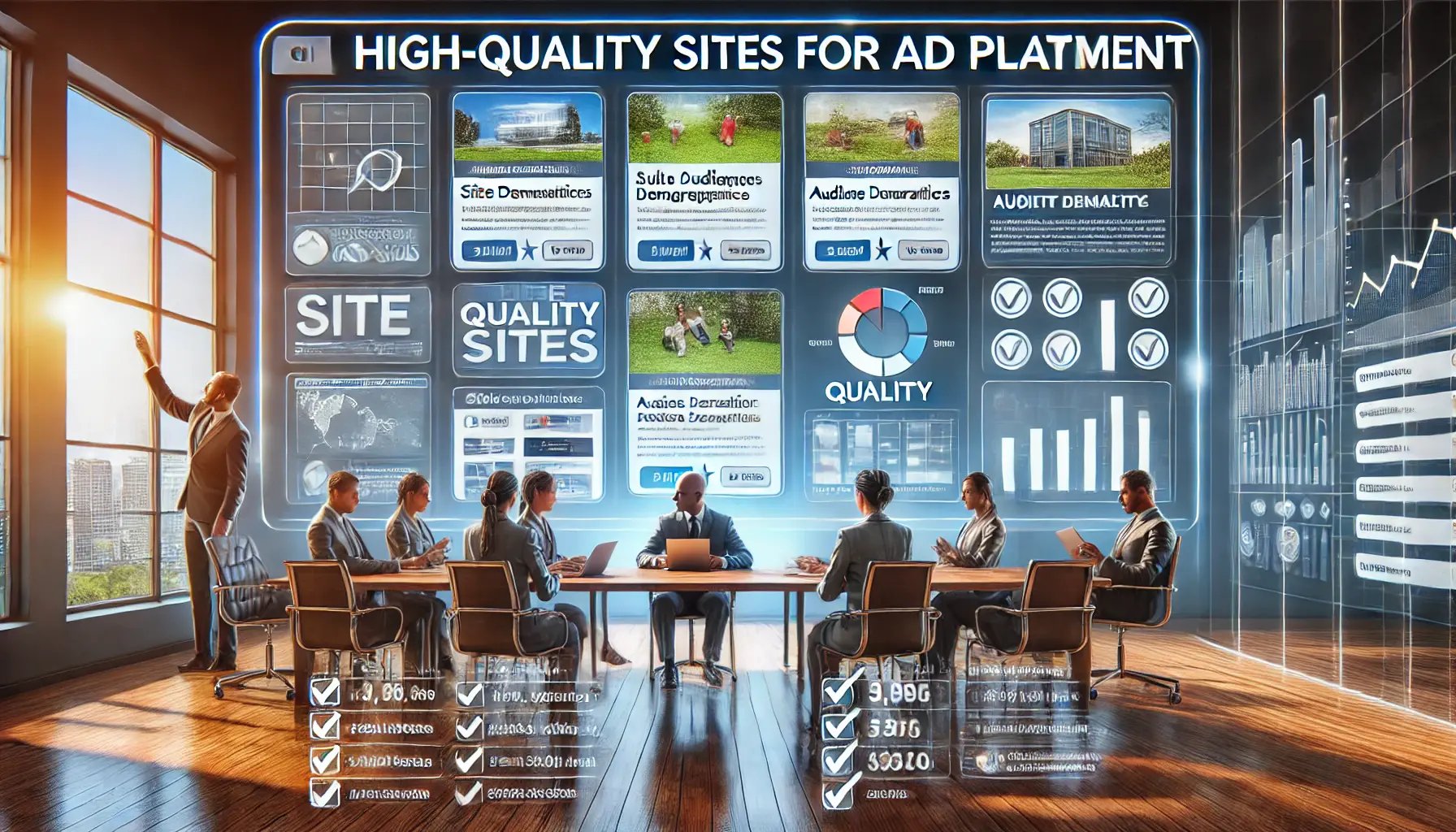
Visual representation of the process of selecting high-quality sites for ad placement in digital marketing.
Choosing High-Quality Sites for Ad Placement
The first step is to select high-quality sites for placing your ads.
Ads on reputable sites are more likely to be trusted and clicked by users.
It’s essential to assess the content of proposed placements, their audience, and overall reputation.
Here are some guidelines to consider:
- Research prospective placements: Before placing your ad on a proposed site, research its reputation and audience demographics to ensure it aligns with your brand and business goals.
- Ensure contextual relevance: Place your ads on sites that are contextually relevant to improve user engagement with your product or service.
- Monitor brand safety: Use tools to vet placements and exclude those that may put your brand in a negative light.
Focusing on quality over quantity will enhance your brand’s performance and reputation.

Visual representation of testing different ad placement strategies in digital marketing.
Testing Different Placement Strategies
Testing various placement strategies is crucial for identifying what works best for your audience.
Valuable insights can be gained by experimenting with ad formats, targeting methods, and placements.
Consider the following approaches to improve the efficiency of your ad placements:
- A/B testing: Run A/B tests to determine which type of ad performs best in specific placements.
- Analyze results: Review test outcomes to identify which placement types yield maximum returns.
- Modify based on feedback: Make adjustments to your ad placements based on test results and emerging insights.
Regular testing and analysis of different strategies will help you refine and enhance ad placements effectively.
Understanding how users interact with ads across devices can also boost engagement rates.
Implementing mobile-friendly ads will ensure they appear seamlessly on mobile devices, as a significant portion of traffic comes from mobile users.
Consider the behavior of users on both mobile and desktop platforms, and adapt placements to suit each environment.
Use responsive display ads that automatically adjust to fit users’ screens, enhancing user experience.
By optimizing for both mobile and desktop placements, you can effectively reach users regardless of their device.

Visual representation of measuring success in Google Ads display campaigns.
Measuring Success in Google Ads Display Campaigns
To ensure the effectiveness of your ad placement strategies, it is essential to measure success using relevant metrics.
Monitoring performance metrics will provide insights into how well your ads are working and identify areas for optimization.
- Key Performance Indicators (KPIs): Set KPIs such as click-through rate (CTR), conversion rate, and return on ad spend (ROAS) to measure campaign success.
- Regular performance reviews: Consistently review ad performance data to identify trends and areas for improvement.
- Iterate and improve: Use insights from your measurements to continually refine your ad placement strategies, ensuring ongoing optimization.
By following these best practices, you can develop more effective ad placement strategies on the Google Display Network, enhancing the overall success of your campaigns and improving results for your business.
Ad placement best practices involve choosing high-quality sites, testing strategies, and setting up mobile-friendly ads. Implement these tips for stronger engagement and a more profitable campaign.

Visual representation of mastering ad placement strategies on the Google Display Network.
Conclusion: How to Master Ad Placement Strategies on Google Display Network
Mastering ad placement strategies on the Google Display Network is critical for any business aiming to increase online visibility and guarantee user engagement.
By understanding and effectively applying methods for successful placements, advertisers can reach the right audience at the right time, significantly enhancing conversions and return on investment.
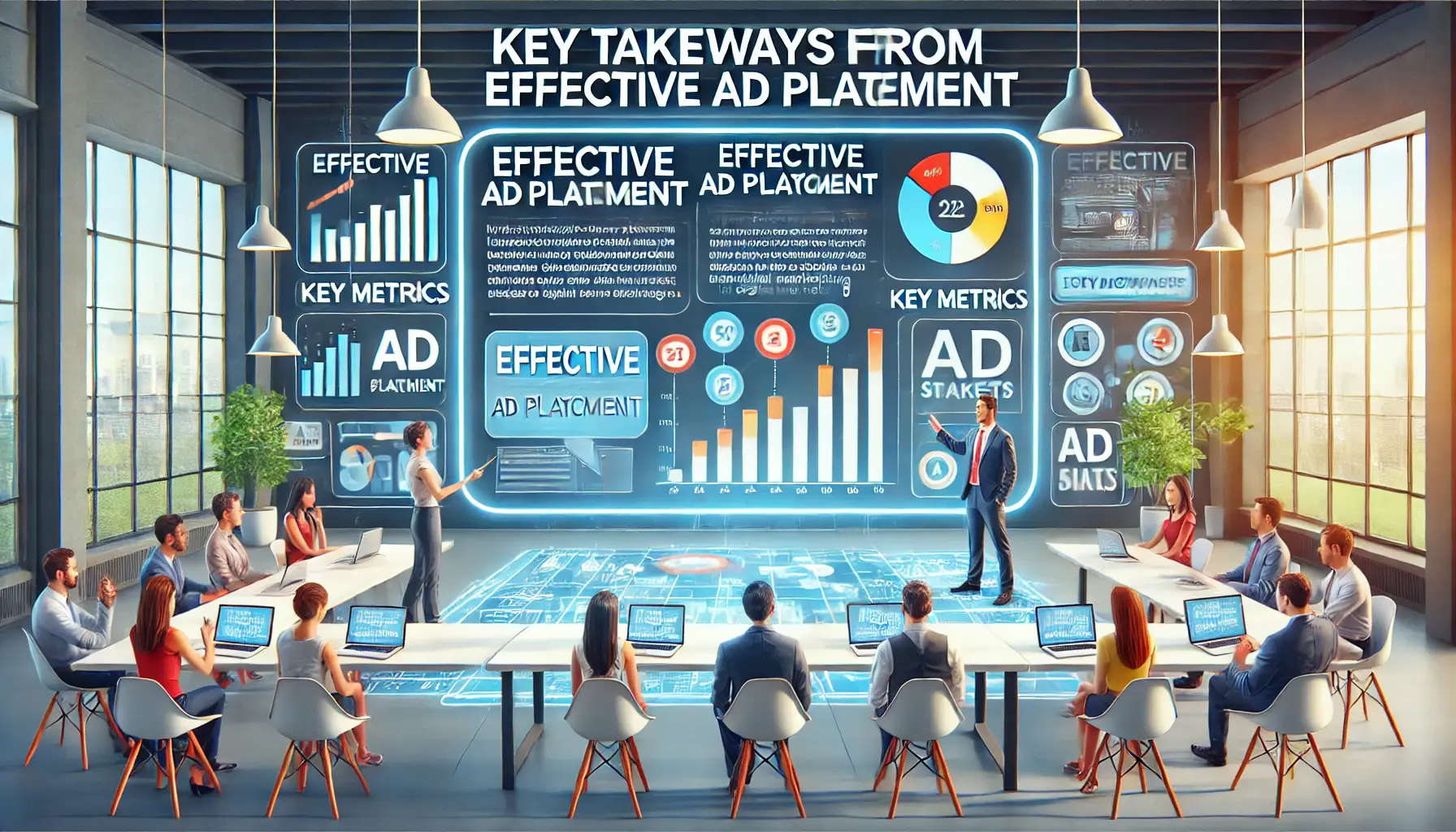
Visual representation of key takeaways from effective ad placement in digital marketing.
Key Takeaways from Effective Ad Placement
Throughout this article, we discussed several key aspects of ad placement strategies, including:
- Choosing Quality Sites: Prioritizing high-quality placements ensures that ads appear in reputable environments, which can enhance trust and engagement.
- Utilizing Various Targeting Techniques: Employing interest, demographic, contextual, and keyword targeting helps refine audience reach and improve ad relevance.
- Testing and Analyzing Strategies: Consistently testing different placements and ad formats is essential to determine what works best for your audience.
- Leveraging Placement Reports: Reviewing performance data provides valuable insights that can substantially improve ad effectiveness.
- Measuring Success: Setting clear KPIs and monitoring performance metrics are crucial for continuous improvement and optimization of ad spending.
By applying these concepts, businesses can create more impactful ad placements that align with their marketing goals and resonate with targeted audiences.
Whether launching a new campaign in Google Ads or optimizing an existing one, these best practices will set you on the right path.

Visual representation of future considerations for ad placement strategies in digital marketing.
Future Considerations for Ad Placement Strategies
As digital marketing continues to evolve, it’s vital to remain flexible and adapt your ad placement strategies to current trends and changing consumer behaviors.
Consider the following:
- AI and Machine Learning: Utilize advanced algorithms to automatically optimize ad placements based on real-time data.
- Video and Interactive Ads: Explore newer creative formats that engage users in innovative ways, increasing the likelihood of conversions.
- Cross-Platform Strategies: Seamlessly integrate Google Ads with other digital marketing channels for cohesive strategies.

Visual representation of closing thoughts on ad placement strategies in digital marketing.
Closing Thoughts
For your Google Ads Display placements to yield substantial results, it is essential to plan, test, and analyze continuously.
Prioritize quality, relevance, and user engagement in your strategies.
By doing so, you will bring a significant difference to your advertising efforts, resulting in better outcomes and an enhanced overall digital presence.
Mastering ad placement strategies on the Google Display Network is essential for any business that wants to achieve better visibility, engagement, and conversions. Optimize your strategies continuously for the best results.

Visual representation of Google Display Network Ad Placement Strategy FAQs.
Your campaigns can be managed by an agency specialized in Google Ads, check out our service page.
Google Display Network Ad Placement Strategy FAQs
This section answers common questions that alleviate confusion and provide valuable insights to advertisers on how to enhance their ad placement strategies on the Google Display Network.
An ad placement strategy refers to how and where your ads appear in the Google Display Network to reach people most interested in your services or products, maximizing visibility and return on investment.
Ad placement strategies are crucial because they ensure that your ads reach the target audience, enhancing visibility, user engagement, and ultimately driving conversions.
Research prospective placements based on audience demographics, content relevance, and overall reputation to ensure they align with your brand values and objectives.
You can utilize interest, demographic, contextual, and keyword targeting to refine audience delivery and improve ad relevance for your campaigns.
Regular testing of ad placements should be conducted continuously to identify what works best for your audience and enhance campaign performance.
Placement reports provide data on the performance of your ads across various sites and apps, allowing you to analyze effectiveness and make informed adjustments.
Make your ads mobile-friendly, use responsive display ads, and consider user behavior on mobile to improve engagement and effectiveness.
Track key metrics like click-through rate (CTRClick-Through Rate, the ratio of users who click on an ad to the number of total users who view it), conversion rateThe percentage of users who complete a desired action, like a purchase, after clicking on an ad, and return on ad spend (ROASReturn on Ad Spend, a metric that measures revenue generated per dollar spent on ads) to gauge the effectiveness of your ad placements.
Yes, you can exclude low-performing or irrelevant placements to optimize your ad spend and improve overall campaign effectiveness.














